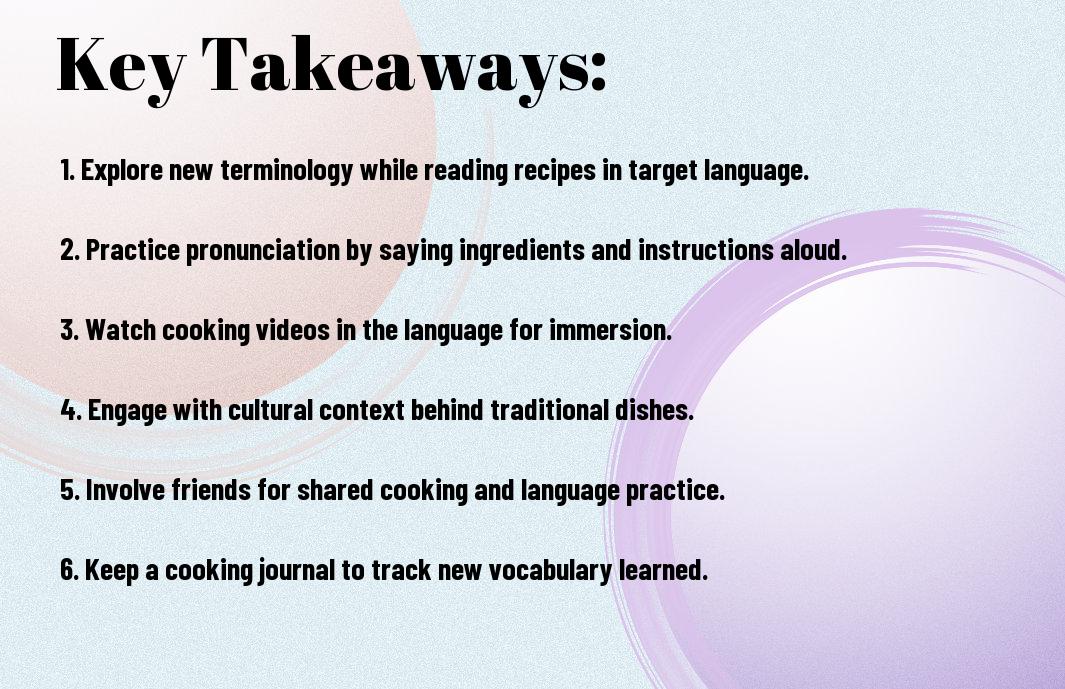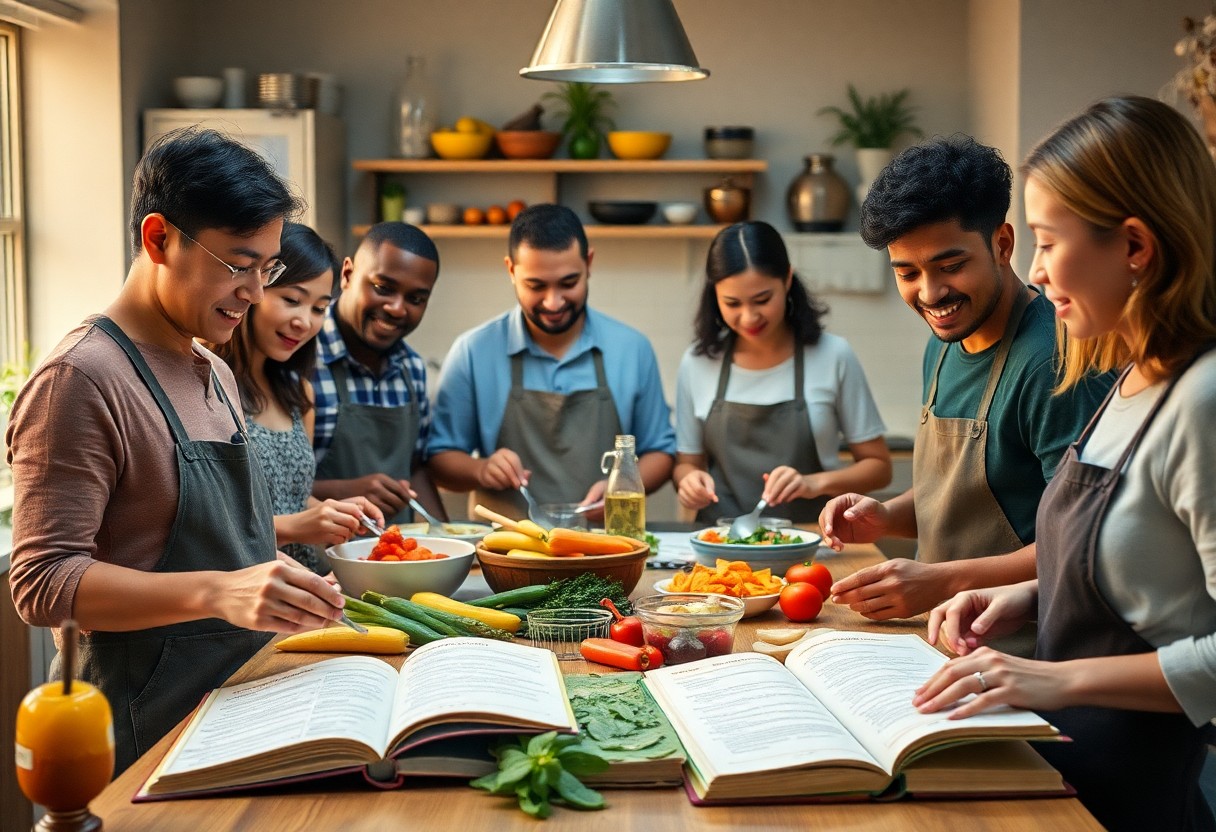You can combine your passion for food and language learning in a unique way. As you explore new cuisines, you’ll discover that cooking and recipes can be a delicious path to language mastery. You can learn more about this approach by checking out The Gourmet Polyglot: Learning Languages Through Food, which highlights the benefits of this method. Your language skills will improve as you cook and learn.
Key Takeaways:
To learn a language through cooking and recipes, consider the following points:
- Learning a language can be a delicious experience when combined with cooking and recipes from the target culture, allowing for a more immersive learning experience.
- Cultural and linguistic insights can be gained by exploring traditional dishes and ingredients from the target language, helping to build vocabulary and phraseology skills.
- Using recipes as a teaching tool can help learners develop their reading, writing, and listening skills, while also providing a sense of accomplishment and motivation to continue learning the language.
Setting the Table
To begin your language learning journey through cooking, you’ll want to explore how recipes can help you learn a new language. You can find more information on this topic at The Language Of Cooking: How Recipes Can Teach You English, which highlights the benefits of using recipes as a language learning tool.
Choosing a Language to Learn
About the language you want to learn, you’ll need to consider your interests and motivation for learning. What culture and cuisine fascinate you, and how can you use recipes to learn the corresponding language?
Selecting Recipes for Language Practice
For your language practice, you’ll want to select recipes that interest you and provide opportunities to learn new vocabulary and grammar. Look for recipes with clear instructions and ingredients you can easily find.
Language learners like you can benefit from choosing recipes with simple, step-by-step instructions, allowing you to focus on the language used in the recipe rather than complicated cooking techniques. As you practice, you’ll become more comfortable with the language and more confident in your ability to understand and use new vocabulary and grammar in context.

Kitchen Essentials
There’s no better way to learn a language than by immersing yourself in the culture, and for you, that starts in the kitchen. You’ll need some basic equipment and ingredients to get started, such as pots, pans, and utensils, as well as a few staple ingredients like olive oil and spices.
Language Learning Tools for the Kitchen
Knownly, kitchen tools can aid in your language learning journey, you can find many recipes and cooking shows with subtitles or translations in your target language, allowing you to learn new vocabulary and phrases while cooking.
Basic Cooking Vocabulary
Cookingly, kitchen basics are important to learn, you should start by learning the names of common ingredients, cooking techniques, and kitchen tools in your target language, this will help you to understand and follow recipes with ease.
Also, as you investigate deeper into the world of cooking and language learning, you’ll find that understanding basic cooking vocabulary is key to unlocking more complex recipes and techniques, and you’ll be able to express yourself with confidence in the kitchen, asking for ingredients, explaining recipes, and sharing your creations with others in your target language.
Recipe for Success
All your efforts to learn a language through cooking will pay off with the right approach, and by following a few simple steps, you can achieve your goals and become proficient in your target language.
Finding Authentic Recipes in the Target Language
Recipes from native speakers will help you discover new vocabulary and phrases, and by searching for them in your target language, you will be able to immerse yourself in the language and get a feel for how it is used in context, which will help you to improve your language skills.
Practicing Language Skills through Meal Preparation
Against the backdrop of a bustling kitchen, you will find opportunities to practice your language skills, from reading recipes to communicating with fellow cooks, and as you work through the preparation of a meal, you will be able to hone your skills in a practical and engaging way.
Even as you follow a recipe, you will be able to practice your listening, speaking, reading, and writing skills, and by using language learning apps, watching cooking videos, or listening to podcasts, you will be able to take your language skills to the next level, and you will find that your ability to communicate in your target language improves with each passing day, as you become more confident and comfortable using the language in a variety of contexts.
Cooking Up Conversations
Unlike other language learning methods, cooking provides a unique opportunity to engage with native speakers and practice your language skills in a practical way. You can find language exchange partners who share your passion for cooking and practice your conversation skills while preparing a meal together.
Using Recipes to Spark Language Practice
Around the kitchen, you’ll discover a wealth of language learning opportunities. You can start by following recipes in the target language, which will help you learn new vocabulary and grammar structures. As you cook, you’ll be able to practice your listening and reading comprehension skills.
Engaging in Culinary Conversations
The moment you step into a kitchen, you’re immersed in a world of culinary conversations. You’ll be discussing ingredients, cooking techniques, and cultural traditions, all of which will help you improve your language skills.
Cooking with others provides a relaxed atmosphere where you can engage in conversations about food, culture, and traditions. As you share recipes and cooking techniques, you’ll be able to practice your speaking and listening skills, and learn about the cultural context of the language you’re learning. You’ll be able to ask questions, share your own experiences, and learn from others, all while enjoying the process of cooking and sharing a meal together.

Taste and Feedback
Now that you’re cooking and exploring new recipes, you’ll start to develop your sense of taste and receive feedback on your language learning progress. This feedback loop is important to improving your language skills, as you’ll be able to identify areas that need improvement and adjust your approach accordingly.
Evaluating Progress in Language Learning
Feedback is key to evaluating your progress in language learning. You’ll be able to gauge your understanding of vocabulary, grammar, and pronunciation, and make necessary adjustments to your learning strategy. As you taste and explore new dishes, you’ll be able to assess your comprehension of recipe instructions and culinary terms.
Adjusting Recipes for Better Learning Outcomes
Adjusting your approach to learning through cooking involves modifying recipes to suit your language level and learning style. You’ll be able to simplify or complicate recipes to challenge yourself and stay engaged, ensuring that you’re consistently learning and improving your language skills.
Outcomes will vary depending on how you adjust your recipes and learning approach. As you modify recipes to suit your needs, you’ll be able to track your progress and identify areas where you need more practice. By doing so, you’ll be able to refine your language skills and develop a more nuanced understanding of the language, allowing you to tackle more complex recipes and culinary concepts with confidence.
Cultural Connections
For language learners, cooking and recipes offer a unique opportunity to connect with the culture behind the language, allowing you to research into the traditions and customs that shape the way people communicate.
Exploring Cultural Contexts through Cuisine
Similarly, one of the most effective ways to learn about a culture is through its cuisine, as you explore the various dishes, ingredients, and cooking techniques that are unique to that culture, giving you a deeper understanding of the language and its context.
Enhancing Language Skills with Cultural Insights
Skilled language learners know that understanding the cultural nuances of a language is important to effective communication, and you can gain valuable insights into these nuances by exploring the cultural context of the recipes and cooking techniques you encounter.
In fact, as you learn more about the cultural insights behind the language, you will find that your language skills improve significantly, allowing you to better understand and communicate with native speakers, and to navigate everyday situations with confidence and precision, making your language learning journey more enjoyable and rewarding.
Conclusion
With these considerations, you can effectively learn a language through cooking and recipes. You will find that your vocabulary and pronunciation improve as you follow recipes and watch cooking videos in your target language. As you progress, your confidence in using the language will grow, and you will develop a new appreciation for the culture behind the cuisine. By combining language learning with your love of cooking, you will stay motivated and engaged in the learning process.
FAQ
Q: What are the benefits of learning a language through cooking and recipes?
A: Learning a language through cooking and recipes offers a unique and engaging approach to language acquisition. By exploring the cuisine of a target language, individuals can develop their vocabulary, grammar, and pronunciation skills in a practical and enjoyable way. This method also allows learners to connect with the culture associated with the language, making the learning process more meaningful and memorable. Furthermore, cooking and recipe-based language learning can be a fun and interactive way to improve language skills, as it involves hands-on activities and real-life applications.
Q: How can I get started with learning a language through cooking and recipes?
A: To get started with learning a language through cooking and recipes, begin by selecting a target language and cuisine that interests you. Look for cookbooks, blogs, or online resources that feature recipes in the target language. Start by reading and translating recipes, and then try cooking the dishes to practice your pronunciation and vocabulary. You can also watch cooking videos or TV shows in the target language to improve your listening skills. Additionally, consider joining online communities or forums where people share recipes and cooking experiences in the target language, allowing you to practice your writing and conversation skills.
Q: What language learning resources are available for learning a language through cooking and recipes?
A: There are numerous language learning resources available for learning a language through cooking and recipes. These include language learning apps, such as Duolingo, that offer cooking-themed lessons and exercises. You can also find YouTube channels and podcasts dedicated to cooking and language learning, featuring recipes, cooking challenges, and cultural insights. Moreover, many online platforms, such as language exchange websites and social media groups, provide opportunities to connect with native speakers and practice language skills through cooking and recipe-sharing. Additionally, local cooking classes, language schools, and cultural centers often offer language courses that incorporate cooking and cuisine, providing a more immersive and interactive learning experience.

